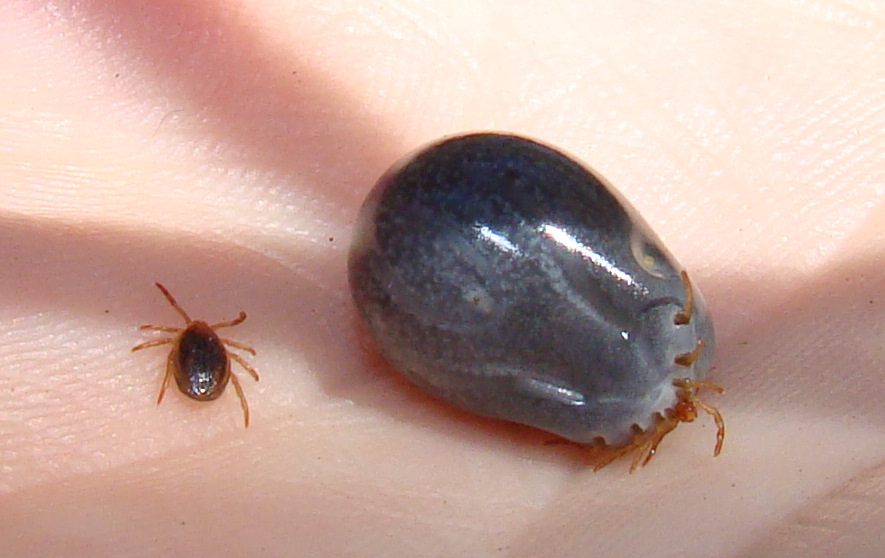TOWNSVILLE PETS AND TICKS- FAQ’s
 Photo credit: Bjørn Christian Tørrissen http://bjornfree.com/galleries.html
sourced at https://en.wikipedia.org/wiki/Ixodes_holocyclus#/media/File:Tick_before_and_after_feeding.jpg
Photo credit: Bjørn Christian Tørrissen http://bjornfree.com/galleries.html
sourced at https://en.wikipedia.org/wiki/Ixodes_holocyclus#/media/File:Tick_before_and_after_feeding.jpg
Do we get paralysis ticks in Townsville?
The main tick of concern for Australian pet owners is the paralysis tick. In Townsville we are lucky that our main suburbs are relatively paralysis tick free and we rarely see tick paralysis cases. However, if you are travelling out of town for only a short distance in any direction your pet is likely to come into contact with these nasty parasites. We have seen cases from as close as Paluma, Hervey’s Range and Toolakea Beach. Brown dog ticks and bush ticks are the most common species of tick to bother Townsville pets. These species do not cause paralysis but can cause skin irritation, anaemia with heavy burdens and can also be vectors of disease.
I found a tick on my dog. How do I tell if it is a paralysis tick?
It’s not easy to identify a tick based on its colour or size as this will vary depending on its level of maturity and blood engorgement. The easiest way to identify a paralysis tick is to examine its legs. The legs are clustered close to the head and the 1st and 4th legs are darker brown compared to the 2nd and 3rd legs. The legs of the other species are of even colour and are spread down the sides of the body. The mouth parts of the paralysis tick are also longer than the other species aiding in their firm attachment.
What do I do if I find a tick on my pet?
Remove the tick immediately. Do this by grasping as close to the head as possible and pulling sideways. Avoid treating the tick with something to kill it first as this may allow the tick more chance of injecting toxin as it dies. If you are concerned about removing the tick please make an appointment so we can do this for you. We also stock tick removing devices that can make removing ticks easier.
If you suspect the tick to be a paralysis tick keep your pet quiet and monitor them closely for the next 48hrs for any signs of paralysis and seek veterinary ASAP if concerned. The earlier you seek treatment for an animal showing signs the better the prognosis for recovery.
What are the symptoms of paralysis ticks?
A paralysis tick will generally cause clinic signs within 3- 7 days of attachment to your pet. The early signs of tick paralysis may make your pet seem a little wobbly/weak or uncoordinated in their back legs as well as symptoms suggesting your pet has something caught in their throat. They may have an altered voice, vomit/ regurgitate food or water. They can develop heavy breathing with a grunt and lose the ability to walk (initially in hind legs progressing front legs). It is important to understand that the symptoms are progressive and can worsen even after the tick is removed. If your pet is showing any of the signs of tick paralysis seek veterinary attention ASAP. Do not offer food or water to a pet showing signs of tick paralysis as their ability to swallow can be impaired.
I’m giving my pet regular tick treatments. Why do I still need to do daily tick searches?
No tick preventative is 100% (especially in the face of high environmental burden) so we recommend daily checking if you are visiting or travelling through a paralysis tick area. The main suburbs of Townsville have a very low incidence of paralysis tick so it is generally not necessary to perform daily checks unless your pet travels outside of the city region.
A thorough search of your pet involves running your fingers through the coat all over their body. Pay particular attention to the face, head, neck, ears, shoulders and under the collar. Be sure to check everywhere including between toes, around genitals, anus, under lips, inside ears, and around eyes. Consider keeping long coated pets clipped over spring and summer if you are travelling to paralysis tick areas so you can search them more easily.
What tick treatments are available for dogs?
We recommend all dogs receive regular flea and tick prevention and with the recent emergence of long lasting oral chews this has become easier than ever to achieve. It can be overwhelming to finding the best product to suit your situation. Please open the link below for an overview of what is available (be aware this is not intended as a replacement for personal veterinary advice). Please contact our friendly team to discuss what is right for your pet.
What can I use on my cat?
There are limited products currently registered for cats. This is due to a number of reasons including the fact cats are more sensitive to many of the chemicals used to control ticks. NEVER APPLY A DOG FLEA OR TICK TREATMENT TO A CAT AS THIS CAN BE FATAL.
Registered products for cats;
- Frontline/ Fipronil Spray- Spray cat every 2-3 weeks
- Fidos Flea and tick concentrate- Leave on rinse applied every 3 days.
If you are travelling to a paralysis tick area with your cat we recommend using tick prevention combined with daily searches.





